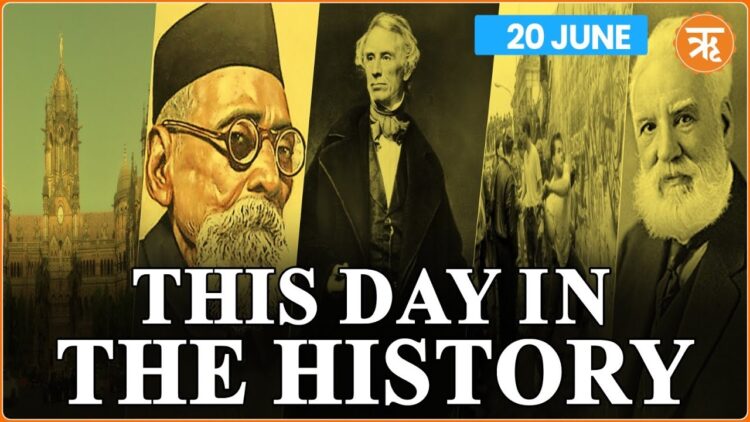Victoria Terminus station, now known as Chhatrapati Shivaji Maharaj Terminus, was completed on June 20, 1887. This historic railway station in Mumbai was inaugurated on the occasion of Queen Victoria’s Golden Jubilee and named in her honor. Designed by British architect Frederick William Stevens, it took about 10 years to construct. In 2004, UNESCO recognized it as a World Heritage Site. Approximately 3 million passengers use this station daily. Before Chhatrapati Shivaji Maharaj Terminus, there was Bori Bunder railway station, from which India’s first train ran to Thane. Due to space constraints at Bori Bunder, the British decided to build a larger station, resulting in the construction of Victoria Terminus. The station was renamed Chhatrapati Shivaji Maharaj Terminus in 1996. The British government allocated 16 lakh rupees for its construction. Currently, the station has 18 platforms, with 7 dedicated to local trains.
– Victoria Terminus station was completed on 20 June 1887
– It was renamed Chhatrapati Shivaji Maharaj Terminus In 1966
– It took about 10 years to build the station
– British government had allotted ₹16 lakhs for its construction
The first class at SNDT Women’s University was held on July 2, 1916, and the initial students graduated in 1921. Initially, the university offered courses in teaching, home science, and other professional fields to women. Over time, it expanded its curriculum to include various disciplines such as science, arts, commerce, and management. The university’s headquarters are located at the Churchgate Campus in Mumbai, with additional campuses in Juhu and Karve Road. Currently, thousands of female students receive education across its many campuses, and the university continues to pursue its mission of providing higher education and empowering women.
– SNDT Women’s University was established on June 20, 1916 in Pune
– It is the first women’s university in India as well as South-East Asia
– This university was founded by Bharat Ratna Maharishi Dr. Dhondo Keshav Karve
On June 20, 1840, Samuel Morse received a US patent for the telegraph, officially granting him the legal rights to the technology he developed. Samuel Morse was an American painter and inventor, best known for creating the telegraph and Morse code. He developed the telegraph during the 1830s and 1840s, and Morse code was co-developed by Morse and his colleague Alfred Vail. This technology revolutionized communication by enabling instant message transmission over long distances. Morse created a prototype of the telegraph, using a system of small and large lines and dots to represent each letter of the English alphabet, which became known as Morse code. To send a message, grooves were made for each letter, and words were formed by arranging these letters. An electric strip was passed over the grooves, turning the electric circuit on and off according to the groove sizes. When the circuit was activated, lines and dots were produced at the receiver end, allowing each letter to be transmitted from one place to another through this system of lines and dots.
– Samuel Morse received a US patent for the telegraph on June 20, 1840
– He was an American painter and inventor.
– Samuel Morse is known for the invention of telegraph and Morse code
On June 20, 1991, the German Parliament held a crucial vote to determine the country’s capital after the demolition of the Berlin Wall in 1989. The Berlin Wall had separated East and West Germany. Previously, Bonn was the capital of West Germany and Berlin of East Germany. The vote was to decide the new unified capital. Berlin secured 337 votes, surpassing Bonn which received 320 votes. Consequently, Berlin became the capital of the newly unified Germany and has held this status since. After World War II, many professionals from East Germany migrated to West Germany, prompting East Germany to build the 155-kilometer-long Berlin Wall in 1961 to stem the exodus.
– Voting held in the German Parliament regarding the country’s capital on June 20,1991
– The Berlin Wall was demolished in the year 1989
– Before the wall collapsed, the capital of West Germany was Bonn
– The capital of East Germany was Berlin before the wall collapsed
On June 20, 1877, the world’s first commercial telephone service was launched in Hamilton, Ontario, Canada. Alexander Graham Bell, who invented the telephone in 1876, initiated this service a year later. The objective was to facilitate easy and accessible communication between businesses and residents. In the same year, Bell established the Bell Telephone Company, which later evolved into the American Telephone and Telegraph Company (AT&T). Alongside the telephone, Bell also invented other devices such as the metal detector and the photophone. The photophone transmitted sound using light rays. Bell’s invention revolutionized communication, spreading rapidly across America, Europe, and beyond, thereby laying the groundwork for a global communication network.
– World’s first commercial telephone service was started on June 20, 1877
– The service started in Hamilton city of Ontario province of Canada
– Alexander Graham Bell invented the metal detector
– He also invented the photophone which transmitted sound using light rays

















Comments